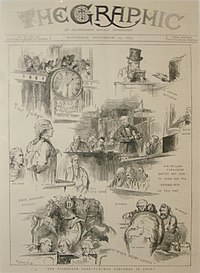The Graphic was a British weekly illustrated newspaper, first published on 4 December 1869 by William Luson Thomas's company Illustrated Newspapers Ltd. Thomas's brother Lewis Samuel Thomas was a co-founder. The premature death of the latter in 1872 "as one of the founders of this newspaper, [and who] took an active interest in its management" left a marked gap in the early history of the publication.[1] It was set up as a rival to the popular Illustrated London News.
The influence of The Graphic within the art world was immense, its many admirers included Vincent van Gogh, and Hubert von Herkomer.[2]
It continued to be published weekly under this title until 23 April 1932 and then changed title to The National Graphicbetween 28 April and 14 July 1932; it then ceased publication, after 3,266 issues. From 1890 until 1926, Luson Thomas's company, H. R. Baines & Co., published The Daily Graphic.
Background[edit]
The Graphic was founded by William Luson Thomas, a successful artist, wood-engraver and social reformer. Earlier he, his brother and his brother-in-law had been persuaded to go to New York and assist in launching two newspapers, Picture Gallery and Republic. Thomas also had an engraving establishment of his own and, aided by a large staff, illustrated and engraved numerous standard works.[3] Exasperated, even angered, by the unsympathetic treatment of artists by the world's most successful illustrated paper, The Illustrated London News, and having a good business sense Luson Thomas resolved to set up an opposition. His illustrated paper, despite being more expensive than its competition, became an immediate success.[2]
Realisation[edit]
When it began in 1869, the newspaper was printed in a rented house. By 1882, the company owned three buildings and twenty printing presses, and employed more than 1,000 people. The first editor was Henry Sutherland Edwards. A successful artist himself, the founder Thomas recruited gifted artists including Luke Fildes, Hubert von Herkomer, Frank Holl, and John Everett Millais.
The Graphic was published on a Saturday and its original cover price was sixpence, while the Illustrated London News was fivepence.[2] In its first year, it described itself to advertisers as "a superior illustrated weekly newspaper, containing twenty-four pages imperial folio, printed on fine toned paper of beautiful quality, made expressly for the purpose and admirably adapted for the display of engravings".
In addition to its home market the paper had subscribers all around the British Empire and North America. The Graphic covered home news and news from around the Empire, and devoted much attention to literature, arts, sciences, the fashionable world, sport, music and opera. Royal occasions and national celebrations and ceremonials were also given prominent coverage.
Artists[edit]
Artists employed on The Graphic and The Daily Graphic at the end of the 19th century and beginning of the 20th century included Helen Allingham, Edmund Blampied, Alexander Boyd, Frank Brangwyn, Randolph Caldecott, Lance Calkin Léon Daviel, John Charles Dollman, James H. Dowd, Godefroy Durand, Luke Fildes, Harry Furniss, John Percival Gülich, George du Maurier, Phil May, George Percy Jacomb-Hood, Ernest Prater, Leonard Raven-Hill, Sidney Sime, Snaffles (Charles Johnson Payne), George Stampa, Edmund Sullivan, Bert Thomas, F. H. Townsend, Harrison Weir, and Henry Woods.
The notable illustrator Henry William Brewer, contributed a regular illustrated article on architecture to the magazine for 25 years, until his death in 1903.[4][5]
Writers[edit]
Writers for the paper included George Eliot, Thomas Hardy, H. Rider Haggard and Anthony Trollope.[6] Malcolm Charles Salaman was employed there from 1890 to 1899. Beatrice Grimshaw travelled the South Pacific reporting on her experiences for the Daily Graphic.[7] Mary Frances Billington served the Graphic as a special correspondent from 1890 to 1897, reporting from India in essays that were compiled into Woman in India (1895).[8] Joseph Ashby-Sterry wrote the Bystander column for the paper for 18 years.
Russo-Turkish War (1877–1878)
The Russo-Turkish War (Turkish: 93 Harbi, lit. 'War of '93', named for the year 1293 in the Islamic calendar; Russian: Русско-турецкая война, romanized: Russko-turetskaya voyna, "Russian–Turkish war") was a conflict between the Ottoman Empire and a coalition led by the Russian Empire which included Bulgaria, Romania, Serbia, and Montenegro.[14] Fought in the Balkans and in the Caucasus, it originated in emerging 19th-century Balkan nationalism. Additional factors included the Russian goals of recovering territorial losses endured during the Crimean War of 1853–1856, re-establishing itself in the Black Sea and supporting the political movement attempting to free Balkan nations from the Ottoman Empire.
The Russian-led coalition won the war, pushing the Ottomans back all the way to the gates of Constantinople, leading to the intervention of the Western European great powers. As a result, Russia succeeded in claiming provinces in the Caucasus, namely Kars and Batum, and also annexed the Budjak region. The principalities of Romania, Serbia, and Montenegro, each of which had had de facto sovereignty for some years, formally proclaimed independence from the Ottoman Empire. After almost five centuries of Ottoman domination (1396–1878), Bulgaria emerged as an autonomous state with support and military intervention from Russia.


